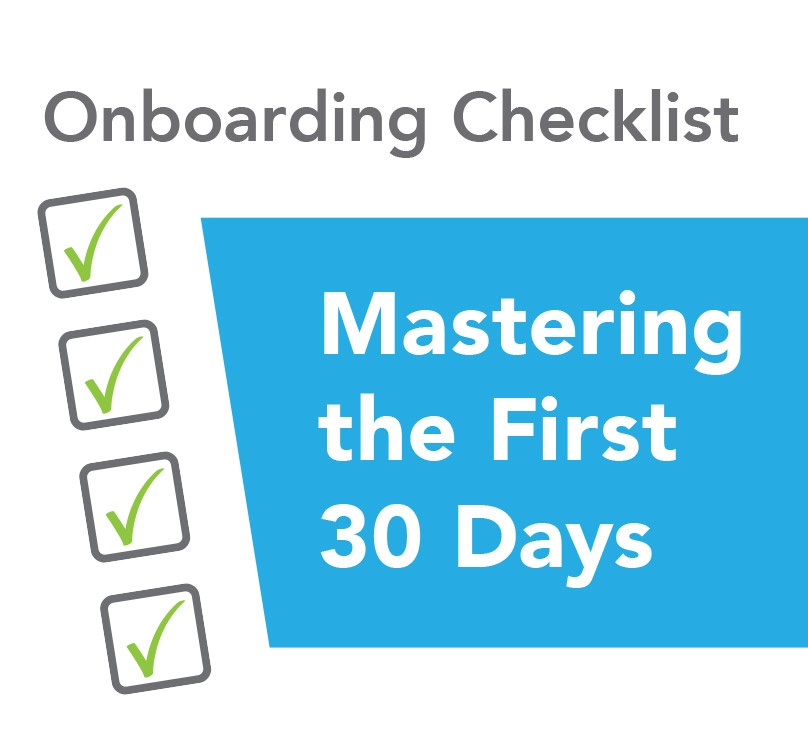 The first 30 days of onboarding are crucial to setting up new hires for success within your organization. It’s during this time they become familiar with the company’s culture, expectations, and objectives.
The first 30 days of onboarding are crucial to setting up new hires for success within your organization. It’s during this time they become familiar with the company’s culture, expectations, and objectives.
Our team compiled a comprehensive Onboarding Checklist for organizations to download and use to streamline their onboarding processes. In this article, we’ll delve into the 5 essential focus areas that make up the first 30 days of onboarding and their accompanying tasks to ensure a smooth transition and a strong start.
Mandatory Orientation
1. Onboarding Paperwork
The first day of a new job often involves an overwhelming amount of paperwork. Streamline this process as much as possible by keeping a running list of all the necessary forms, documents, and legal requirements that need to be completed. This ensures employees have a clear understanding of their responsibilities from day one and can begin their work with confidence.
2. Finish New Hire Training
Training is a fundamental component of successful onboarding. During the first 30 days, new employees should complete any mandatory training programs related to their roles. This may include online courses, in-person training sessions, or shadowing experienced colleagues. Completing these training programs equip new hires with the knowledge and skills required to excel in their positions.
3. Complete Required Safety Training
Safety is a top priority in any organization. It’s essential to ensure new employees are well-versed in the safety protocols and practices relevant to their roles. The completion of safety training programs within the first 30 days keeps employees safe and helps in preventing workplace accidents and injuries.
Expectations and Objectives
1. Go Over New Hire Roles & Responsibilities within Your Organization
During the onboarding process, new employees should have a clear understanding of their roles and responsibilities. This includes not only the tasks they will perform, but also their broader contribution to the organization’s goals. Discussing these roles and responsibilities ensures new hires align their actions with the company’s expectations.
2. Work on Goal Setting: What Do You Want to See in Their First 30/60/90 Days?
Setting goals is a critical step in any employee’s journey. During the first 30 days, it’s essential to sit down with new hires and discuss their objectives and expectations for their initial months. This not only provides a roadmap for their development but also allows for regular check-ins to assess their progress.
Organizational Map
1. Offer Opportunities for New Hires to Learn More about the Company
Fostering a deep understanding of the organization is vital. New employees should have access to resources that help them learn about the company’s history, values, and mission. This knowledge creates a sense of belonging and purpose.
2. Inform Them of Key Roles within the Organization and Their Specific Team
Introduce new hires to key roles and players within the organization. This not only helps them understand the company’s structure, but also facilitates networking and collaboration. Encourage open communication and create a supportive environment where they can reach out to their colleagues for assistance.
3. Establish a List of FAQs that Have Come Up with Previous New Hires
Compile a list of frequently asked questions that new hires typically encounter during their first month. By addressing these common queries proactively, you can save time and reduce confusion. Make this FAQ accessible and encourage new hires to refer to it whenever they have questions.
Company Culture and Values
1. Arrange a Welcome Call with the Office – Something Casual to Meet the Team
Building a sense of camaraderie is vital for integrating new hires into the company culture. Organize a casual welcome call or meeting with the team to break the ice and create a warm, welcoming atmosphere.
2. Give Them Access to Your Organization’s Team Communications Platforms
Open lines of communication are crucial for new hires to feel part of the team. Grant them access to your organization’s team communication platforms, such as Slack or Microsoft Teams. This allows them to connect with colleagues, seek assistance, and participate in ongoing discussions.
Feedback and Support
1. Find a Mentor for Your New Hire to Communicate with Regularly
Mentorship can be a valuable resource for new hires. Pair them with a mentor who can provide guidance, answer questions, and offer insights into company culture and best practices.
2. Ensure There Are Regular Check-Ins to Get Any Questions Answered that Come Up
Regular check-ins are a necessary component of the onboarding process. Encourage open communication by scheduling regular one-on-one meetings between new hires and their managers. These meetings provide an opportunity to address questions, concerns, and track progress.
3. Offer Encouragement as They Navigate Their New Role
Support and encouragement are essential during the early stages of employment. Acknowledge the challenges new hires may face and offer positive reinforcement to boost their confidence.
In conclusion, the first 30 days of onboarding are a critical phase in a new employee’s journey. A well-structured onboarding process, encompassing mandatory orientation, clear expectations and objectives, organizational understanding, company culture, and ongoing support, sets the foundation for their long-term success within the organization. By investing in a comprehensive onboarding program, companies can ensure that new hires quickly become productive, engaged, and aligned with the company’s goals.
Reminder: Don’t forget to download our Onboarding Checklist for a quick reference!
